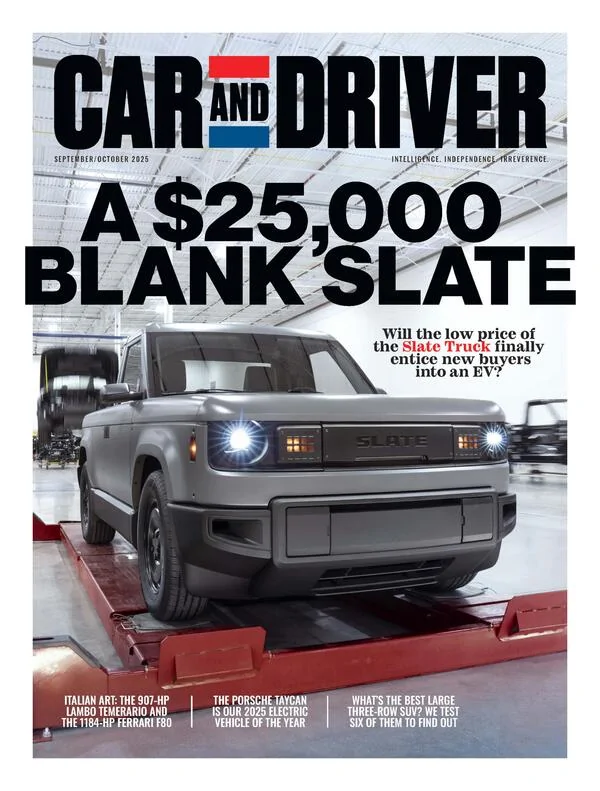cadblu
Well-Known Member
- Thread starter
- #1

Luckily, I subscribe to Car & Driver, and pleased to share with my colleagues on this forum!
Enjoy!!
SLATE EXPECTATIONS
This radical new pickup is set to become one of the most affordable vehicles in the U.S. market.
By Greg Fink
Photography by John Roe
Introduction
IN THE UNITED STATES, affordable automobiles are right there with the red wolf, California condor, and black-footed ferret on the endangered-species list. Just two dozen of the hundreds of new car, truck, van, and SUV models for 2025 sticker for less than $27,000. Not one is a pickup or an electric vehicle.
Upstart automaker Slate aims to fill those voids with its Truck, a battery-powered pickup boasting a starting price that we estimate will be around $25,000.
With failure rates for EV startups rivaling those of the romantic relationships coming out of the reality show Love Island USA, the odds are stacked against Slate. Don’t write off the fledgling brand just yet, though. Unlike nascent EV automakers that have gone belly-up, Slate has more than just a concept of a plan to bring its vehicle to market.
Based in Troy, Michigan, Slate began in 2022 as a project within Re:Build Manufacturing, a conglomerate co-founded by Jeff Wilke, former CEO of Amazon’s worldwide consumer business. It has $700 million in backing raised over two seed rounds. Supporters include Amazon founder Jeff Bezos’s investment firm Bezos Expeditions, global investment company General Catalyst, and multinational holding company TWG Global.
Manufacturing Plan
Slate has a manufacturing plan in place too. The company is in the process of building out a former printing plant in Warsaw, Indiana, with production set to kick off in the latter half of 2026 and deliveries promised shortly thereafter. If all goes to plan, the 1.4-million-square-foot factory will eventually have the capacity to build 150,000 Trucks per year.
Like Lucid, Rivian, and Tesla, Slate is eschewing a dealership model in favor of direct sales. Unlike those three, the brand is shunning storefronts entirely, instead partnering with a proven dealer chain for delivery and an established national auto-shop group as a service partner.
Design and Features
The Truck’s five-foot bed is nearly half a foot longer than a Maverick’s. Its door count, however, is half that of the Ford.
The Truck’s infotainment is BYO. A phone dock comes standard, while a tablet mount will be an available accessory.
The compact Truck is as simple as its name. To streamline production, Slate plans for every Truck to leave the line essentially identical. There’s just one exception: the underfloor battery pack.
Battery and Range
Supplied by SK On and built in the U.S., the standard battery offers 47 kWh of usable capacity, affording the Truck a manufacturer-estimated driving range of 150 miles. Spend a few stacks extra to nab the long-range pack with a net capacity of around 75 kWh, and the Truck will go a claimed 240 miles on a charge.
Regardless of pack, every Truck includes a NACS port. Slate claims both packs offer a peak charge speed of 120 kilowatts. That isn’t a headline rate, but mega charge speed for a battery of this size isn’t necessary.
Performance and Capability
A single rear-mounted motor produces 201 horsepower and 195 pound-feet of torque, which Slate says can push its approximately 3700-pound Truck to 60 mph in 8.0 seconds. Trucks with the 300-pound-heavier long-range pack will surely need a few more tenths to hit the mile-a-minute mark.
With the standard battery, the payload and towing capacities of the Truck max out at 1433 and 1000 pounds. Payload with the large-capacity pack drops to 1131 pounds; towing capacity remains the same. (For comparison, the front-drive Ford Maverick Hybrid’s payload and towing capacities max out at 1500 and 2000 pounds.)
Slate saved money using lots of off-the-shelf parts, but it designed its own de Dion rear axle.
Cost-Saving Choices
To hit its price target, Slate also limits body-style choices and offers just one color scheme for the exterior and interior.
All Trucks will leave the factory in two-seat, single-cab configuration with a five-foot bed, donning unpainted and largely dent-resistant gray polypropylene-composite body panels (similar to dearly departed Saturn’s) and a black and gray interior.
Slate anticipates saving hundreds of millions of dollars by circumventing the need for a paint shop or metal stamping presses for body-panel production at its factory. Buyers looking for more color can add it via the brand’s accessories division, which will offer partial and full exterior wraps (even extending the design to the flat-faced 17-inch steel wheels) and seat covers in various hues.
Interior and Tech
The same applies to comfort and convenience items. While it has power locks, a keyless entry system, air conditioning, cruise control, and a 4.3-inch digital gauge cluster that also displays the backup camera’s feed, the Truck is devoid of frills.
Slate includes neither audio nor infotainment systems. Rather, a universal charging dock comes standard, since the expectation is that your personal device with its integrated speaker will fill those roles.
The accessories team, however, will hawk you a set of dedicated dash-mounted speakers, a holder to clip in a Bluetooth speaker, or a tablet-compatible charging dock for those who prefer a personal infotainment system with a larger screen.
Not a fan of the Truck’s crank windows? Then consider adding the accessory power-window kit.
Storage and Versatility
Forgoing a front motor leaves space for a sizable seven-cubic-foot frunk. That’s about the same as a Tesla Cybertruck’s. Like the Tesla, the Slate leaves the factory unpainted. Vinyl wraps are available for those looking for some color.
Also available are lift and lowering kits, center-console and door-mounted storage add-ons, alloy wheel options, and even a kit that enables owners to turn their two-seat truck into a five-seat SUV.
The likely four-figure accessory package offers a bed-mounted three-across rear bench seat, a roll bar replete with integrated airbags, and a removable hard top; it adds about 310 pounds too.
Whether installing accessories or removing body panels, owners have Slate’s blessing to tinker with all but the high-voltage power system of their Trucks, with the company offering a library of tutorials it calls Slate University.
Size and Space
Despite casting a shadow an inch shorter than a Mazda 3 hatchback, the 174.6-inch-long Truck offers sufficient space for a pair of full-size adults relegated to the SUV kit’s rear bench.
Cargo room behind the second row is adequate, and there’s at least enough space for a quartet of carry-on bags. Need to haul a few more things? Then open up the seven-cubic-foot front trunk, which also serves as a covered and lockable storage alternative to the five-foot bed of the Truck’s default pickup body.
The frunk space is the result of Slate forgoing the option of fitting the Truck with a front motor.
That also means the Truck is strictly a rear-wheel-drive affair. Without all-wheel drive available, the Truck won’t be venturing too far off-road.
The accessories group, however, has a 2.0-inch lift kit and all-terrain tires for Truck owners looking for that off-tarmac tough look or the option to drive down the very beaten path more comfortably.
Maybe Slate will go so far as to sell an accessory front-drive motor at a later date. If so, the company just might manage to pull off the trifecta of making an affordable pickup, EV, and off-roader. In the meantime, though, two out of three ain’t bad.
Analysis
Margin Calls
“The real challenge,” says Tyson Jominy, senior vice president of data and analytics at J.D. Power, “is that EVs typically have a worse margin up front” than internal-combustion vehicles.
Jominy puts a typical EV’s margins at 10 to 15 percent. Slate’s is likely even lower, given the cancellation of the $7500 federal tax credit toward the purchase of a new EV. Slate originally factored that direct-to-buyer cash into the base price of the Truck, a sum that would have pushed the purchase total below $20,000.
Slate’s accessory-driven business model may somewhat offset the slimmer margins on the Truck itself. Ryan Maguire, CEO of the marketing firm Helm, notes that an automaker’s range of accessories typically nets profit margins of “anywhere from 25 to 40 percent.”
And that’s not including the approximate 30 to 35 percent margins enjoyed by the dealerships and service departments that sell these parts. Given Slate’s direct-sales model, the automaker could be looking at profit margins of 50 to 70 percent on the Truck’s many accessory items.
Parts and Accessories
Poppin’ Tops
Slate will offer squareback (below, top) and raked-glass fastback versions of its SUV kit.
Making the Truck a five-seater requires removing the sail panel aft of the B-pillar and moving the rear window to the removable hard top (the fastback gets new glass). The company is also crash-testing the setup, which includes a rear roll cage and curtain airbags.
The three-abreast rear-bench design requires the roll protection to be in place for its installation, avoiding an unsafe configuration. We expect Slate to offer an accessory bikini top at some point as well.
By the Numbers
Rate of Refueling
At current averages, a Slate Truck is less expensive to operate than a Ford Maverick Hybrid if electricity costs $0.26 per kilowatt-hour or less.
